|
Nocturnal owls are formidable, silent hunters. Their silence on the wing derives from the structural modification of the first primary feather on each wing, a trait shared by all owls. The forward edge of the feather is serrated rather than smooth, which has the effect of disrupting the flow of air over the wing in flight and eliminating the vortex noise created by airflow over a smooth surface. Thus equipped, owls arrive upon their prey without a sound. Owls, especially those that hunt at night, are able to locate even faint sounds with remarkable accuracy. The best studied of these nocturnal predators is the Barn Owl. Extensive experiments conducted by neurobiologists Marc Konishi and Eric Knudsen in totally darkened, soundproofed rooms have unequivocally demonstrated that Barn Owls can locate and capture prey by sound alone. The Barn Owl's sensitive hearing is enhanced by its facial ruff, a concave surface of stiff dark-tipped feathers. The ruff functions as a reflector, channeling sounds into the ears. Once a sound is detected, the owl orients toward it and accurately pinpoints its location to within 1.5 degrees in both horizontal and vertical planes. The cue used to determine whether a sound comes from the right, left, or straight ahead is the difference in time that it takes for a sound to reach each ear. When the sound source is dead ahead, no time differential occurs. Another cue, the difference in intensity of sound received by each ear, is used to localize a sound vertically. Barn Owls (Tyto species), along with owls of at least eight other genera, have asymmetrical openings to their ears -- as shown in the accompanying figure. A sound coming from above will seem slightly louder in the ear with the higher opening; if a sound is equally loud in both ears then the source must be at eye level. The owls' ears are linked to specialized cells contained within a discrete region of the midbrain. Each cell is sensitive to a unique combination of time and intensity differentials and responds only to sound issuing from one small area in space. The Barn Owl's brain thus contains a "neural map" of auditory space. So armed, it is little wonder that the Barn Owl has been so successful that today it is arguably the most widespread bird species on Earth.
But their auditory systems are not the only reason that some owls can hunt successfully in the dark. Their sensory abilities are coupled with sedentary habits. As shown in studies of Tawny Owls in England, individuals hold a hunting territory in which they operate night after night. Familiarity with the environment, especially such things as the heights of favorite perches above the ground, seems to be essential to the owls' ability to pounce on prey. Hearing helps to replace the absence of sight, but intimate knowledge of the habitat completes the job. SEE: Raptor Hunting; Size and Sex in Raptors; Site Tenacity; Pellets Copyright ® 1988 by Paul R. Ehrlich, David S. Dobkin, and Darryl Wheye. |
